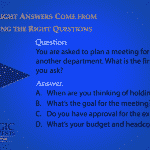The holy trio of a company consists of?


I consider a tripod a metaphor for events. Event Strategists represent one leg, marketing teams another, and sales the third. Events are the platform that sit atop the three legs. With all parts in place and equal, the tripod is solid, functioning, and stable. When one leg is off balance or missing, the integrity of the entire piece is affected.
Event planners are often operating in a silo, (one legged tripod) or work with only the sales or marketing team. There is no regular communication between the three departments, meaning no unified message or connection between the sales and marketing goals, initiatives, and the events being produced. So, at best, your tripod has two legs.

If your marketing team designs logos and collateral but isn’t contributing to the content and messaging, that’s not a partnership. That’s a parallel silo. Same thing if sales provides the guest list and dictates the size and scope of the event and isn’t seen again until the night of the event.
Strategic planners create healthy, interactive relationships with their marketing and sales colleagues. They see themselves as peers, not less important than other executives; they own the value strategic meetings bring to organizations, act with confidence, and get things done. Their events are a reflection or picture of the company’s message and are built on a solid platform.
To create the relationships needed to do this, you must understand some basic principles of human nature and behavior. People’s compulsion to answer the question, ‘What’s in it for me?’ drives all their actions. Think about it; if you buy someone an extravagant gift, you’re doing it to fulfill YOUR wish to do so. The gift is no less generous, but the root of it comes from your desire. We do things based on choice; even when we feel as if we don’t have one, we are deciding that doing something we prefer not to do is preferable to facing the consequences of not doing it.
Providing a compelling answer to the, ‘What’s in it for me?’ question, influences behavior. For planners working with external audiences, this translates to increased attendance. For internal audiences (and external) it means more engaged audiences. If you plan strategically, you can get people to do what you want them to do because they want to do it.
Your first goal is to create a strategy, aligning events with the marketing and sales departments. There are often egos, politics, territorial battles, and invisible yet powerful lines between departments that create a vast divide. That means you need to genuinely believe in the power of strategic events as you have your work cut out for you.
Let’s start with the sales team. Potential obstacles:
- They have priorities above meeting with you.
- They don’t understand events beyond their current involvement.
- You fear they don’t see you as an equal.
Next: What gets a sales team’s attention?
- Making more money.
- Beating the competition.
- Being the best.
Now let’s take what we know and use it advantageously:
Except for product launches, events don’t sell products. They create the motivation that sells them. When properly executed, they shorten, support, enhance, and advance the sales cycle. Partnering to create an event that supports the internal sales strategy means the event advances the message and can be designed around sales goals. Using the information gained from your discovery session (see in the Summer 2017 issue at MWMeet.com/Summer2017ds) you know what the audience needs, and what key stakeholders expect. Marry those two priceless pieces of information with the sales initiatives, and you have a powerful plan starting to take form.
A better trained and motivated sales force translates to higher sales, which means less competition and more money. That should get their attention. Now we need to weave marketing into the plan.
Potential obstacles:
- Territorial issues often prevent collaboration.
- Money is always an issue; who’s paying for this?
- They have other priorities.
What gets a marketing team’s attention?
- Effective campaigns.
- Increased sales.
- Proof that their efforts are influencing positive behavior.
With sales on board, you have a powerful ally to bring the marketing team on board. Here are potential talking points: marketing campaigns are created to support sales’ efforts, but how often are the people who are supposed to be using the materials given the opportunity to share input, have the pieces explained to them, and brainstorm on how to best use them? Events are the ideal forum to bring marketing messages to life, embody the essence of the campaign, utilize the concepts, and facilitate the sales process. By working together, the marketing team gains valuable feedback, shares insight on why campaigns were created, and best utilizes the tools they create. Sounds like things that motivate their behavior, doesn’t it?
The strategic planning team is the third in the trio; they architect and execute the plan. They are the visionaries who bring the messages together and create an environment that will deliver maximum learning, sharing, interaction; whatever the goal. When all sides are allowed to shine and are able to simultaneously focus on their goals while leveraging the talents of others in the organization, the results are exponentially rewarding.
With all three pieces in place, having equal input, influence, and responsibility, our tripod has three solid, even legs on which to build our event. And with that sturdy tripod in place, get ready for your close up; you are on your way to becoming an Event Strategist.





